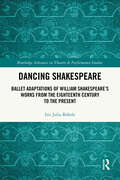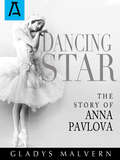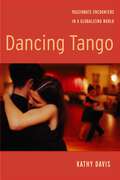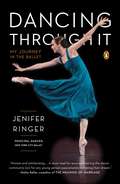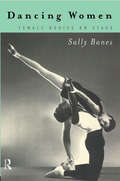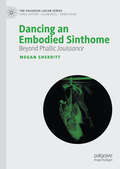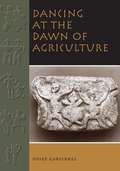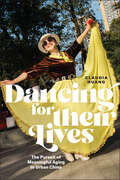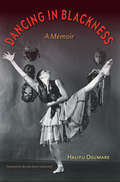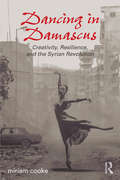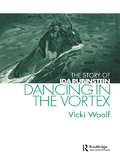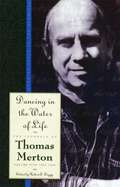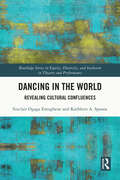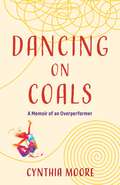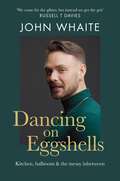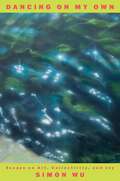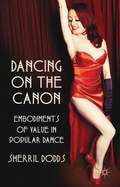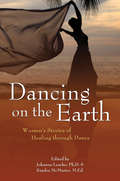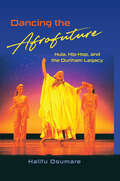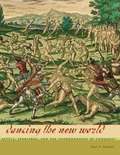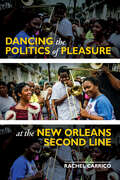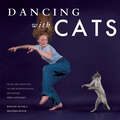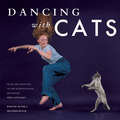- Table View
- List View
Dancing Shakespeare: Ballet Adaptations of William Shakespeare’s Works from the Eighteenth Century to the Present (Routledge Advances in Theatre & Performance Studies)
by Iris Julia BührleDancing Shakespeare is the first history of ballets based on William Shakespeare’s works from the birth of the dramatic story ballet in the eighteenth century to the present. It focuses on two main questions: "How can Shakespeare be danced?" and "How can dance shed new light on Shakespeare?"The book explores how librettists and choreographers have transposed Shakespeare’s complex storylines, multifaceted protagonists, rhetoric and humour into non-verbal means of expression, often going beyond the texts in order to comment on them or use them as raw material for their own creative purposes.One aim of the monograph is to demonstrate that the study of wordless performances allows us to gain a deeper understanding of Shakespeare’s texts. It argues that ballets based on Shakespeare’s works direct the audience’s attention to the "bare bones" of the plays: their situations, their characters, and the evolution of both. Moreover, they reveal and develop the "choreographies" that are written into the texts and highlight the importance of movements and gestures as signifiers in Shakespeare’s plays.This book will be of interest to students and scholars of literature, dance, and music, as well as to an international readership of lovers of Shakespeare, ballet, and the arts.
Dancing Star: The Story of Anna Pavlova
by Gladys MalvernIn this biographical novel, Gladys Malvern shares the incredible story of Anna Pavlova, one of the most revered and celebrated ballerinas of all time. Malvern presents Pavlova's life in enchanting prose, allowing the reader to experience Pavlova's inspirational first exposure to a performance of Sleeping Beauty, the origination of her defining dance The Dying Swan, her illustrious rise to fame as a prima ballerina, and her extensive world tours. You don't have to be a fan of the ballet to enjoy this captivating tale, available for the first time in ebook.
Dancing Tango: Passionate Encounters in a Globalizing World
by Kathy DavisArgentinean tango is a global phenomenon. Since its origin among immigrants from the slums of Buenos Aires and Montevideo, it has crossed and re-crossed many borders.Yet, never before has tango been danced by so many people and in so many different places as today. Argentinean tango is more than a specific music and style of dancing. It is also a cultural imaginary which embodies intense passion, hyper-heterosexuality, and dangerous exoticism.In the wake of its latest revival, tango has become both a cultural symbol of Argentinean national identity and a transnational cultural space in which a modest, yet growing number of dancers from different parts of the globe meet on the dance floor.Through interviews and ethnographical research in Amsterdam and Buenos Aires, Kathy Davis shows why a dance from another era and another place appeals to men and women from different parts of the world and what happens to them as they become caught up in the tango salon culture. She shows how they negotiate the ambivalences, contradictions, and hierarchies of gender, sexuality, and global relations of power between North and South inwhich Argentinean tango is—and has always been—embroiled.Davis also explores her uneasiness about her own passion for a dance which—when seen through the lens of contemporary critical feminist and postcolonial theories—seems, at best, odd, and, at worst, disreputable and even a bit shameful. She uses the disjuncture between the incorrect pleasures and complicated politics of dancing tango as a resource for exploring the workings of passion as experience, as performance, and as cultural discourse. She concludes that dancing tango should be viewed less as a love/hate embrace with colonial overtones than a passionate encounter across many different borders between dancers who share a desire for difference and a taste of the ‘elsewhere.’ Dancing Tango is a vivid, intriguing account of an important global cultural phenomenon.
Dancing Through It
by Jenifer RingerA behind-the-curtains look at the rarefied world of classical ballet from a principal dancer at the New York City Ballet In her charming and self-effacing voice, Jenifer Ringer covers the highs and lows of what it's like to make it to the top in the exclusive, competitive ballet world. From the heart-pounding moments waiting in the wings before a performance to appearing on Oprah to discuss weight and body image among dancers, Dancing Through It is moving and revelatory. Raised in South Carolina, Ringer led a typical kid's life until she sat in on a friend's ballet class, an experience that would change her life forever. By the age of twelve she was enrolled at the elite Washington School of Ballet and soon moved to the School of American Ballet. At sixteen she was a professional dancer at the New York City Ballet in Manhattan, home of the legendary George Balanchine and Jerome Robbins. Ringer takes us inside the dancer's world, detailing a typical day, performance preparation, and the extraordinary pressures that these athletes face. Ringer shares exhilarating stories of starring in Balanchine productions, working with the famous Peter Martins, and of meeting her husband and falling in love at the New York City Ballet. Ringer also talks candidly of Alistair Macauley's stinging critique of her weight in his 2010 New York Times review of The Nutcracker that ignited a public dialogue about ballet and weight. She unflinchingly describes her personal struggles with eating disorders and body image, and shares how her faith helped her to heal and triumph over these challenges.
Dancing Women: Female Bodies Onstage
by Sally BanesDancing Women: Female Bodies Onstage is a spectacular and timely contribution to dance history, recasting canonical dance since the early nineteenth century in terms of a feminist perspective. Setting the creation of specific dances in socio-political and cultural contexts, Sally Banes shows that choreographers have created representations of women that are shaped by - and that in part shape - society's continuing debates about sexuality and female identity. Broad in its scope and compelling in its argument Dancing Women: * provides a series of re-readings of the canon, from Romantic and Russian Imperial ballet to contemporary ballet and modern dance * investigates the gaps between plot and performance that create sexual and gendered meanings * examines how women's agency is created in dance through aspects of choreographic structure and style * analyzes a range of women's images - including brides, mistresses, mothers, sisters, witches, wraiths, enchanted princesses, peasants, revolutionaries, cowgirls, scientists, and athletes - as well as the creation of various women's communities on the dance stage * suggests approaches to issues of gender in postmodern dance Using an interpretive strategy different from that of other feminist dance historians, who have stressed either victimization or celebration of women, Banes finds a much more complex range of cultural representations of gender identities.
Dancing an Embodied Sinthome: Beyond Phallic Jouissance (The Palgrave Lacan Series)
by Megan SherrittThis book provides the first in-depth analysis of Lacanian psychoanalytic theory and the art of dance and explores what each practice can offer the other. It takes as its starting point Jacques Lacan’s assertion that James Joyce’s literary works helped him create what Lacan terms a sinthome, thereby preventing psychosis. That is, Joyce’s use of written language helped him maintain a “normal” existence despite showing tendencies towards psychosis. Here it is proposed that writing was only the method through which Joyce worked but that the key element in his sinthome was play, specifically the play of the Lacanian real.The book moves on to consider how dance operates similarly to Joyce’s writing and details the components of Joyce’s sinthome, not as a product that keeps him sane, but as an interminable process for coping with the (Lacanian) real. The author contends that Joyce goes beyond words and meaning, using language’s metre, tone, rhythm, and cadence to play with the real, mirroring his experience of it and confining it to his works, creating order in the chaos of his mind. The art of dance is shown to be a process that likewise allows one to play with the real. However, it is emphasized that dance goes further: it also teaches someone how to play if one doesn't already know how. This book offers a compelling analysis that sheds new light on the fields of psychoanalysis and dance and looks to what this can tell us about—and the possibilities for—both practices, concluding that psychoanalysis and dance both offer processes that open possibilities that might otherwise seem impossible. This original analysis will be of particular interest to those working in the fields of psychoanalysis, aesthetics, psychoanalytic theory, critical theory, art therapy, and dance studies.
Dancing at the Dawn of Agriculture
by Yosef GarfinkelAs the nomadic hunters and gatherers of the ancient Near East turned to agriculture for their livelihood and settled into villages, religious ceremonies involving dancing became their primary means for bonding individuals into communities and households into villages. So important was dance that scenes of dancing are among the oldest and most persistent themes in Near Eastern prehistoric art, and these depictions of dance accompanied the spread of agriculture into surrounding regions of Europe and Africa. In this pathfinding book, Yosef Garfinkel analyzes depictions of dancing found on archaeological objects from the Near East, southeastern Europe, and Egypt to offer the first comprehensive look at the role of dance in these Neolithic (7000-4000 BC) societies. In the first part of the book, Garfinkel examines the structure of dance, its functional roles in the community (with comparisons to dance in modern pre-state societies), and its cognitive, or symbolic, aspects. This analysis leads him to assert that scenes of dancing depict real community rituals linked to the agricultural cycle and that dance was essential for maintaining these calendrical rituals and passing them on to succeeding generations. In the concluding section of the book, Garfinkel presents and discusses the extensive archaeological data—some 400 depictions of dance—on which his study is based.
Dancing for Their Lives: The Pursuit of Meaningful Aging in Urban China (Global Perspectives on Aging)
by Claudia HuangDancing for Their Lives explores the vibrant world of retired Chinese women known as "dancing grannies” who seek fulfillment and companionship amidst societal upheaval. These women, part of China’s “lost generation,” gather in parks and public squares to reclaim their lives through dance in the wake of Chinese economic and cultural transformations. The book challenges prevailing narratives of aging societies, portraying old age as a site of social innovation rather than decline. Based on ethnographic research conducted in Chengdu, China, Dancing for Their Lives reveals how retirees learn to navigate shifting social norms and values while actively creating new models for growing older. The book’s insights resonate beyond Chinese society, offering lessons on resilience and the pursuit of meaning in any aging population. Dancing for Their Lives underscores the human capacity to craft purposeful lives amid uncertainty, transcending geographical boundaries to illuminate the universal quest for fulfillment in later years.
Dancing in Blackness: A Memoir
by Halifu OsumareDancing in Blackness is a professional dancer's personal journey over four decades, across three continents and 23 countries, and through defining moments in the story of black dance in America. In this memoir, Halifu Osumare reflects on what blackness and dance have meant to her life and international career. Osumare's story begins in 1960s San Francisco amid the Black Arts Movement, black militancy, and hippie counterculture. It was there, she says, that she chose dance as her own revolutionary statement. Osumare describes her experiences as a young black dancer in Europe teaching "jazz ballet" and establishing her own dance company in Copenhagen. Moving to New York City, she danced with the Rod Rodgers Dance Company and took part in integrating the programs at the Lincoln Center. After doing dance fieldwork in Ghana, Osumare returned to California and helped develop Oakland’s black dance scene. Osumare introduces readers to some of the major artistic movers and shakers she collaborated with throughout her career, including Katherine Dunham, Pearl Primus, Jean-Leon Destine, Alvin Ailey, and Donald McKayle. Now a black studies scholar, Osumare uses her extraordinary experiences to reveal the overlooked ways that dance has been a vital tool in the black struggle for recognition, justice, and self-empowerment. Her memoir is the inspiring story of an accomplished dance artist who has boldly developed and proclaimed her identity as a black woman.
Dancing in Damascus: Creativity, Resilience, and the Syrian Revolution
by miriam cookeOn March 17, 2011, many Syrians rose up against the authoritarian Asad regime that had ruled them with an iron fist for forty years. Initial successes were quickly quashed, and the revolution seemed to devolve into a civil war pitting the government against its citizens and extremist mercenaries. As of late 2015, almost 300,000 Syrians have been killed and over half of a total population of 23 million forced out of their homes. Nine million are internally displaced and over four million are wandering the world, many on foot or in leaky boats. Countless numbers have been disappeared. These shocking statistics and the unstoppable violence notwithstanding, the revolution goes on. The story of the attempted crushing of the revolution is known. Less well covered has been the role of artists and intellectuals in representing to the world and to their people the resilience of revolutionary resistance and defiance. How is it possible that artists, filmmakers and writers have not been cowed into numbed silence but are becoming more and more creative? How can we make sense of their insistence that despite the apocalypse engulfing the country their revolution is ongoing and that their works participate in its persistence? With smartphones, pens, voices and brushes, these artists registered their determination to keep the idea of the revolution alive. Dancing in Damascus traces the first four years of the Syrian revolution and the activists’ creative responses to physical and emotional violence.
Dancing in the Vortex: The Story of Ida Rubinstein (Choreography and Dance Studies Series #Vol. 20.)
by Vicki WoolfParis at the turn of the century - Art Nouveau, Renoir, Toulouse-Lautrec and the Folies Bergere. This was the atmosphere which nurtured the artistic development of the remarkable dancer and choreographer Ida Rubinstein.This long-awaited biography gives us a unique insight into the life of a remarkable woman, responsible for a fascinating chapter of our artistic heritage. She was a chameleon, a diva, who lived many lives, overcoming the anti-Semitism of her times to enchant and captivate the highest of societies.Untrained as a dancer, Ida Rubinstein's charisma attracted collaborators such as Debussy, Stravinsky, Ravel, Cocteau, Bakst, and Benois.
Dancing in the Water of Life
by Thomas MertonThe sixties were a time of restlessness, inner turmoil, and exuberance for Merton during which he closely followed the careening development of political and social activism - Martin Luther King, Jr., and the March on Selma, the Catholic Worker Movement, the Vietnam war, and the assassination of John F. Kennedy. Volume 5 chronicles the approach of Merton's fiftieth birthday and marks his move to Mount Olivet, his hermitage at the Abbey of Gethsemani, where he was finally able to fully embrace the joys and challenges of solitary life: 'In the hermitage, one must pray of go to seed. The pretense of prayer will not suffice. Just sitting will not suffice . . . Solitude puts you with your back to the wall (or your face to it!), and this is good' (13 October, 1964).
Dancing in the Water of Life
by Thomas MertonThe sixties were a time of restlessness, inner turmoil, and exuberance for Merton during which he closely followed the careening development of political and social activism - Martin Luther King, Jr., and the March on Selma, the Catholic Worker Movement, the Vietnam war, and the assassination of John F. Kennedy. Volume 5 chronicles the approach of Merton's fiftieth birthday and marks his move to Mount Olivet, his hermitage at the Abbey of Gethsemani, where he was finally able to fully embrace the joys and challenges of solitary life: 'In the hermitage, one must pray of go to seed. The pretense of prayer will not suffice. Just sitting will not suffice . . . Solitude puts you with your back to the wall (or your face to it!), and this is good' (13 October, 1964).
Dancing in the World: Revealing Cultural Confluences (Routledge Series in Equity, Diversity, and Inclusion in Theatre and Performance)
by Sinclair Ogaga Emoghene Kathleen A. SpanosHow can we create more inclusive spaces in the field of dance? This book presents a framework for dance practitioners and researchers working in diverse dance cultures to navigate academia and the professional dance field. The framework is based on the idea of "cultural confluences," conjuring up an image of bodies of water meeting and flowing into and past one another, migrating through what they refer to as the mainstream and non-mainstream. These streams are fluid categories that are associated with power, privilege, and the ability (or inability) to absorb other cultural forms in shared dance spaces. In reflective interludes and dialogues, Emoghene and Spanos consider the effects of migration on their own individual experiences in dance to understand what it means to carry culture through the body in various spaces. Through an analysis of language, aesthetic values, spaces, creative processes, and archival research practices, the book offers a collaborative model for communicating the value that marginalized dance communities bring to the field. This book will be of great interest to students, scholars, and arts administrators in dance.
Dancing on Coals: A Memoir of an Overperformer
by Cynthia MooreAn award-winning playwright's story of her madcap race to find fame or enlightenment, whichever comes first— perfect for fans of Lori Gottlieb's Maybe You Should Talk to Someone.In Dancing on Coals, Cynthia Moore describes a multi-decade, harebrained search for love in all the wrong places, starting when her narcissistic mother abandons her to a Swiss finishing school. Desperately seeking belonging, she leapfrogs from a polyamorous commune into a high-octane all-male performance group, dancing as if her life depends on it. When she finally quits the theater, earns a masters degree in psychology and develops her own therapeutic approach, she is able to heal herself and find the true belonging and peace she longs for. At times humorous and self-deprecating, at times poignant and heartbreaking, this is the story of one woman's path from abandonment to wholeness and authenticity.
Dancing on Eggshells: Kitchen, ballroom & the messy inbetween
by John Whaite'We come for the glitter, but instead we get the grit, in stories told with insight, tenderness and joy.' - Russell T DaviesWith a foreword by Steph McGovern'I never thought I'd write a memoir. I never thought I'd do a lot of the things I have done in my thirty-four years, but life has a wonderful way of surprising us.'Well-known as the winner of the third series of The Great British Bake Off and runner up of Strictly Come Dancing with his same-sex dance partner Johannes Radebe, John Whaite's personal story is a complicated narrative of contradictions, highs and lows, told with tenderness, joy, insight and wit, but also unflinching honesty. A shy little boy from rural Lancashire, who was scared to sleep alone and danced a little 'too gay' at family weddings, he was also an unruly teen who shaved a checkerboard pattern into his hair and refused to conform. From childhood his life has revolved around food - his parents owned a fish and chip shop where John worked in the back peeling potatoes - but for long periods he has been haunted by bulimia and body dysmorphia and not a day goes by when he doesn't worry about what or how much he eats. He achieved TV fame but then seemingly wilfully chose to self-destruct, before finding the strength to pull back when he woke up in a car with half a kebab at his feet and chilli sauce on his shoes. Through it all, his essential optimism has meant that he has chosen to take every step back as a chance to reassess and begin again, finally arriving at the realisation that external validation and fulfilment is transient - a distraction from the sometimes painful pilgrimage we make as we gain wisdom from our experiences.
Dancing on Eggshells: Kitchen, ballroom & the messy inbetween
by John Whaite'We come for the glitter, but instead we get the grit, in stories told with insight, tenderness and joy.' - Russell T DaviesWith a foreword by Steph McGovern'I never thought I'd write a memoir. I never thought I'd do a lot of the things I have done in my thirty-four years, but life has a wonderful way of surprising us.'Well-known as the winner of the third series of The Great British Bake Off and runner up of Strictly Come Dancing with his same-sex dance partner Johannes Radebe, John Whaite's personal story is a complicated narrative of contradictions, highs and lows, told with tenderness, joy, insight and wit, but also unflinching honesty. A shy little boy from rural Lancashire, who was scared to sleep alone and danced a little 'too gay' at family weddings, he was also an unruly teen who shaved a checkerboard pattern into his hair and refused to conform. From childhood his life has revolved around food - his parents owned a fish and chip shop where John worked in the back peeling potatoes - but for long periods he has been haunted by bulimia and body dysmorphia and not a day goes by when he doesn't worry about what or how much he eats. He achieved TV fame but then seemingly wilfully chose to self-destruct, before finding the strength to pull back when he woke up in a car with half a kebab at his feet and chilli sauce on his shoes. Through it all, his essential optimism has meant that he has chosen to take every step back as a chance to reassess and begin again, finally arriving at the realisation that external validation and fulfilment is transient - a distraction from the sometimes painful pilgrimage we make as we gain wisdom from our experiences.
Dancing on My Own: Essays on Art, Collectivity, and Joy
by Simon WuA The Millions and Hyperallergic Most Anticipated Book of 2024 | A Publishers Weekly Summer Reads Pick“Simon Wu manages to be both a shrewd critic and enthused aspirant of what passes for today’s cultural capital. . . . with a disarming lack of cynicism that is both keen and refreshing.” –Cathy Park Hong"A genius melding of art criticism, autobiography, personal essay, and travel writing. . . . Wu—an artist, curator, and writer—layers experiences like translucent curtains through which we see the landscape of a past in the present making its future." –Claudia RankineAn expansive and deeply personal essay collection which explores the aesthetics of class aspiration, the complications of creating art and fashion, and the limits of identity politics.In Robyn’s 2010 track Dancing on My Own, the Swedish pop-singer chronicles a night on the dance floor in the shadow of a former lover. She is bitter, angry, and at times desperate, and yet by the time the chorus arrives her frustration has melted away. She decides to dance on her own, and in this way, she transforms her solitude into a more complex joy. Taking inspiration from Robyn’s seminal track, emerging art critic and curator Simon Wu dances through the institutions of art, capitalism, and identity in these expertly researched, beautifully rendered essays. In “A Model Childhood” he catalogs the decades’ worth of clutter in his mother’s suburban garage and its meaning for himself and his family. In “For Everyone,” Wu explores the complicated sensation of the Telfar bag (often referred to as “the Brooklyn Birkin”) and asks whether fashion can truly be revolutionary in a capitalist system—if something can truly be “for everyone” without undercutting someone else. Throughout, Wu centers the sticky vulnerability of living in a body in a world where history is mapped into every choice we make, every party drug we take, and every person we kiss.Wu’s message is that to dance on your own is to move from critique into joy. To approach identity with the utmost sympathy for the kinds of belonging it might promise, and to look beyond it. For readers of Cathy Park Hong and Alexander Chee, Dancing on My Own is a deeply felt and ultimately triumphant anthem about the never-ending journey of discovering oneself, and introduces a brilliant new writer on the rise.
Dancing on the Canon
by Sherril DoddsEmploying a cultural theory approach, thisbook explores the relationship between popular dance and value. It traces the shifting value systems that underpin popular dance scholarship and considers how different dancing communities articulate complex expressions of judgment, significance and worth through their embodied practice. "
Dancing on the Earth
by Sandra Mcmaster Johanna LesehoThe essays in this dynamic compilation are a testament to dance as a healing art. Widely interdisciplinary in nature and written by women dancers from around the world, they illustrate a rich array of dance practices, cultures, and disciplines and show how this expressive therapy can be both empowering and exhilarating. The women's narratives all share a deep appreciation for the connection between mental, spiritual, and physical dimensions, offering dance as a transformative power of renewing and rebuilding that bond. Both personal and professional, the stories weave a vivid tapestry of lived experiences and insights, balance, and a community healed by dance.
Dancing the Afrofuture: Hula, Hip-Hop, and the Dunham Legacy
by Halifu Osumare<p class="MsoNormal" style="margin-bottom:0in;margin-bottom:.0001pt;line-height: normal;mso-pagination:none;mso-layout-grid-align:none;text-autospace:none"><span style="font-size:12.0pt;font-family: "Times New Roman",serif">A Black dancer chronicles her career as a scholar writing the stories of global hip-hop and Black culture <p class="MsoNormal" style="margin-bottom:0in;margin-bottom:.0001pt;line-height: normal;mso-pagination:none;mso-layout-grid-align:none;text-autospace:none"> <p class="MsoNormal" style="margin-bottom:0in;margin-bottom:.0001pt;line-height: normal;mso-pagination:none;mso-layout-grid-align:none;text-autospace:none">Dancing the Afrofuture is the story of a dancer with a long career of artistry and activism who transitioned from performing Black dance to writing it into history as a Black studies scholar. Following the personal journey of her artistic development told in Dancing in Blackness, Halifu Osumare now reflects on how that first career—which began during the 1960s Black Arts Movement—has influenced her growth as an academic, tracing her teaching and research against a political and cultural backdrop that extends to the twenty-first century with Black Lives Matter and a potent speculative Afrofuture. <p class="MsoNormal" style="margin-bottom:0in;margin-bottom:.0001pt;text-indent: .5in;line-height:normal">Osumare describes her decision to step away from full-time involvement in dance and community activism to earn a doctorate in American studies from the University of Hawai‘i. She emulated the model of her mentor Katherine Dunham by studying and performing hula, and her research on hip-hop youth culture took her from Hawai‘i to Africa, Europe, and South America as a professor at the University of California, Davis. Throughout her scholarly career, Osumare has illuminated the resilience of African-descendant peoples through a focus on performance and the lens of Afrofuturism. <p class="MsoNormal" style="margin-bottom:0in;margin-bottom:.0001pt;text-indent: .5in;line-height:normal">Respected for her work as both professional dancer and trailblazing academic, Osumare shares experiences from her second career that show the potential of scholarship in revealing and documenting underrecognized stories of Black dance and global pop culture. In this memoir, Osumare dances across several fields of study while ruminating on how the Black past reveals itself in the Afro-present that is transforming into the Afrofuture. <p class="MsoNormal" style="margin-bottom:0in;margin-bottom:.0001pt;line-height: normal"> <p class="MsoNormal" style="margin-bottom:0in;margin-bottom:.0001pt;line-height: normal">Publication of this work made possible by a Sustaining the Humanities through the American Rescue Plan grant from the National Endowment for the Humanities and a University of California, Davis Edward A. Dickson Emeriti Professorship Award.
Dancing the New World: Aztecs, Spaniards, and the Choreography of Conquest
by Paul A. ScolieriFrom Christopher Columbus to "first anthropologist" Friar Bernardino de Sahagún, fifteenth- and sixteenth-century explorers, conquistadors, clerics, scientists, and travelers wrote about the "Indian" dances they encountered throughout the New World. This was especially true of Spanish missionaries who intensively studied and documented native dances in an attempt to identify and eradicate the "idolatrous" behaviors of the Aztec, the largest indigenous empire in Mesoamerica at the time of its European discovery. Dancing the New World traces the transformation of the Aztec empire into a Spanish colony through written and visual representations of dance in colonial discourse-the vast constellation of chronicles, histories, letters, and travel books by Europeans in and about the New World. Scolieri analyzes how the chroniclers used the Indian dancing body to represent their own experiences of wonder and terror in the New World, as well as to justify, lament, and/or deny their role in its political, spiritual, and physical conquest. He also reveals that Spaniards and Aztecs shared an understanding that dance played an important role in the formation, maintenance, and representation of imperial power, and describes how Spaniards compelled Indians to perform dances that dramatized their own conquest, thereby transforming them into colonial subjects. Scolieri's pathfinding analysis of the vast colonial "dance archive" conclusively demonstrates that dance played a crucial role in one of the defining moments in modern history-the European colonization of the Americas.
Dancing the Politics of Pleasure at the New Orleans Second Line
by Rachel CarricoOn many Sundays, Black New Orleanians dance through city streets in Second Lines. These processions invite would-be spectators to join in, grooving to an ambulatory brass band for several hours. Though an increasingly popular attraction for tourists, parading provides the second liners themselves with a potent public expression of Black resistance. Rachel Carrico examines the parading bodies in motion as a form of negotiating and understanding power. Seeing pleasure as a bodily experience, Carrico reveals how second liners’ moves link joy and liberation, self and communal identities, play and dissent, and reclamations of place. As she shows, dancers’ choices allow them to access the pleasure of reclaiming self and city through motion and rhythm while expanding a sense of the possible in the present and for the future. In-depth and empathetic, Dancing the Politics of Pleasure at the New Orleans Second Line blends analysis with a chorus of Black voices to reveal an indelible facet of Black culture in the Crescent City.
Dancing with Cats: From The Creators Of The International Best Seller Why Cats Paint
by Heather Busch Burton SilverThe cult classic is back! This 15th anniversary edition keeps all the original mystery and magic of cat dancing delightfully intact. Perpetually ahead of its time, Dancing with Cats presents scores of delightful and inspiring photographs of people and cats engaging in their favorite dance routines as well as moving testimonies of the personal transformations brought about through this uniquely joyous form of human-animal connection. Dancing with Cats will have a new generation of cat lovers (and their cats) jumping for joy--and cutting a rug--in no time.
Dancing with Cats: From the Creators of the International Best Seller Why Cats Paint
by Heather Busch Burton SilverThe cult classic is back! This 15th anniversary edition keeps all the original mystery and magic of cat dancing delightfully intact. Perpetually ahead of its time, Dancing with Cats presents scores of delightful and inspiring photographs of people and cats engaging in their favorite dance routines as well as moving testimonies of the personal transformations brought about through this uniquely joyous form of human-animal connection. Dancing with Cats will have a new generation of cat lovers (and their cats) jumping for joy—and cutting a rug—in no time.
